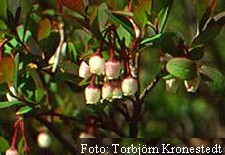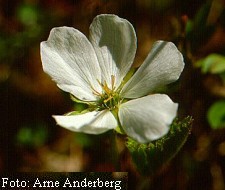|
From
a rearranged translation of Vladimir
Dinets original pages to norwegian,
with supplements.

Klikk på flagg for norsk versjon

Little bunting, Emberiza pusilla, Coal Mines, Chukotka,
Russia.
|
The Little Bunting, Emberiza pusilla,
is a passerine bird. It belongs to the bunting and American
sparrow family Emberizidae,
a group separated by most modern authors from the true finches
Fringillidae.
This is a small bunting at 12–13.5 centimetres in length.
It has a heavily streaked brown back and white underparts
with fine dark streaking. With its chestnut face and white malar
stripe, it resembles a small female Reed
Bunting,
but has black crown stripes, a white eye-ring, and a fine dark
border to the rear of its chestnut cheeks. Sexes are
similar. The call is a distinctive zik, and the song is a rolling
siroo-sir-sir-siroo.
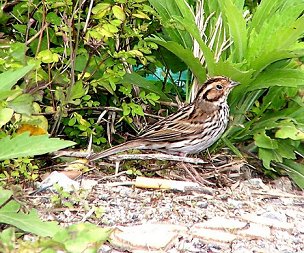 Little
Bunting Emberiza pusilla
Little
Bunting Emberiza pusilla
Photo:
Charles Lam,
http://en.wikipedia.org/wiki/File:Little_Bunting.jpg
|
The Little Bunting breeds across the taiga of the far northeast
of Europe and northern Asia. It is migratory, wintering
in the subtropics in northern India, southern China and the
northern parts of southeast Asia. The birds remain in their
winter quarters for quite long; specimens were taken in Yunnan
in late March. It is a rare vagrant to western Europe. This
species is adaptable; in the mountains of Bhutan for example,
where small numbers winter, it is typically found in agricultural
habitat, mostly between 1,000 and 2,000 metres asl.
It breeds in open coniferous woodland, often with some birch
or willow. 4–6 eggs are laid in a tree nest.
Its natural food consists of insects when feeding young, and
otherwise seeds.
A common and widely-ranging species, it is not considered threatened
on the IUCN Red List. |
Southern tundras have much more shrubs than typical tundras: in
some places you have to make your way
through alder, birch and willow forests up to 3 m tall. Just ten years
ago they were very local north from
Anadyr River, but now they cover extensive areas in river valleys
and foothills all over Chukotka,
except for the Arctic Coast.
Northern Bilberry, Vaccinium uliginosum,
(Bog Bilberry) is a flowering plant in the genus Vaccinium
Vaccinium uliginosum is native to cool temperate regions of
the Northern Hemisphere, at low altitudes in the Arctic, and
at high altitudes south to the Pyrenees, the Alps, and the Caucasus
in Europe, the mountains of Mongolia, northern China and central
Japan in Asia, and the Sierra Nevada in California and the Rocky
Mountains in Utah in North America.
It grows on wet acidic soils on heathland, moorland, tundra,
and in the understory of coniferous forests, from sea level
in the Arctic, up to 3,400 metres (11,200 ft) altitude in the
south of the range.
Vaccinium uliginosum is a small deciduous shrub growing to cm
10–75 centimetres (0.33–2.46 ft) tall, rarely 1 metre
(3.3 ft) tall, with brown stems (unlike the green stems of the
closely related Bilberry). The leaves are oval, 4–30 millimetres
(0.16–1.2 in) long and 2–15 millimetres (0.079–0.59
in) wide, blue-green with pale net-like veins, with a smooth
margin and rounded apex.
The flowers are pendulous, urn-shaped, pale pink, 4-6 mm long,
produced in mid spring. The fruit is a dark blue-black berry
5–8 millimetres (0.20–0.31 in) diameter, with a white
flesh, edible and sweet when ripe in late summer.
Source: http://en.wikipedia.org/wiki/Vaccinium_uliginosum
Cloudberry,
Rubus
chamaemorus
(Greek
chamai "on the ground", moros "mulberry")
is a rhizomatous herb native to alpine and arctic tundra and
boreal forest, producing amber-colored edible fruit similar
to the raspberry or blackberry. English common names include
cloudberry, bakeapple (in Atlantic Canada), Knotberry and Knoutberry
(in England), Averin and Evron (in Scotland).
Unlike most Rubus species, the cloudberry is dioecious, and
fruit production by a female plant requires pollination
from a male plant.
The cloudberry grows to 10–25 cm high. The leaves alternate
between having 5 and 7 soft, handlike lobes on straight, branchless
stalks. After pollination, the white (sometimes reddish-tipped)
flowers form raspberry-sized berries. Encapsulating between
5 and 25 drupelets, each fruit is initially pale red, ripening
into an amber color in early autumn.
The cloudberry can withstand cold temperatures down to well
below -40°C, but is sensitive to salt and to dry conditions.
It grows in bogs, marshes and wet meadows and requires sunny
exposures in acidic ground (between 3.5 and 5 pH).
Cloudberry leaves are food for caterpillars of several Lepidoptera
species. The moth Coleophora thulea has no other known foodplants.
Source: http://en.wikipedia.org/wiki/Rubus_chamaemorus |
These shrublands are difficult to cross and full of bugs in summer,
but they are a much better place
than typical tundras for surviving the winter. A lot of wildlife uses
them as shelter

Ioanna River Valley. |

Ioanna River Valley. |

Ioanna River Valley |
Rivers of Chukotka flow over permafrost so they erode their banks
rather than bottoms.
Most of them consist of countless channels, and can be difficult to
cross

River delta, Cross Bay, Chukotka. |

River valley, Cross Bay, Chukotka. |
Rivers of Chukotka flow over permafrost so they erode their banks
rather than bottoms.
Most of them consist of countless channels, and can be difficult to
cross

Birch bolete (Leccinum scabrum), Volchya Valley. |

Mosquitoes, Sbornaya River |
Tattlers are rare inhabitants of river valleys. Gray-tailed tattler
inhabits wet, broad valleys and deltas,
while wandering tattler, Tringa
incana, prefers fast foothill rivers with riparian
forests, and nests on trees
A riparian forest is a forested area of land adjacent to a body
of water such as a river,
stream, pond, lake, marshland, estuary, canal, sink or reservoir.
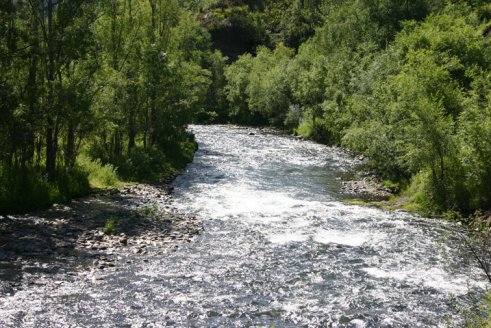 Kopylie
River is a 90-km long high-gradient stream, which is flowing
through the valleys of the Central-Kamchatka Ridge, the spine
of the peninsula. Kopylie is
Kopylie
River is a 90-km long high-gradient stream, which is flowing
through the valleys of the Central-Kamchatka Ridge, the spine
of the peninsula. Kopylie is
one of the sources of the Icha River, flowing to the west,
into the Sea of Okhotsk.
Source: http://flyfishingrussia.blogspot.com/2011/10/kopylie-river-kamchatka.html |

Gray-tailed tattler, Tringa brevipes,
Cross Bay. |
|

Gray-tailed tattler, Cross Bay |
The Grey-tailed Tattler, Tringa brevipes (formerly
Heteroscelus brevipes), is a small shorebird.
The Grey-tailed Tattler is closely related to its North American
counterpart, the Wandering Tattler, Tringa incana, and
is difficult to distinguish from that species. Both tattlers
are unique among the species of Tringa for having unpatterned,
greyish wings and back, and a scaly breast pattern extending
more or less onto the belly in breeding plumage, in which both
also have a rather prominent supercilium.
These birds resemble Common
Redshanks in shape and size. The upper parts, underwings,
face and neck are grey, and the belly is white. They have short
yellowish legs and a bill with a pale base and dark tip. There
is a
weak supercilium.
They are very similar to their American counterpart, and differentiation
depends on details like the length of the nasal groove and scaling
on the tarsus. The best distinction is the call; Gray-tailed
has a disyllabic whistle, and Wandering a rippling trill.
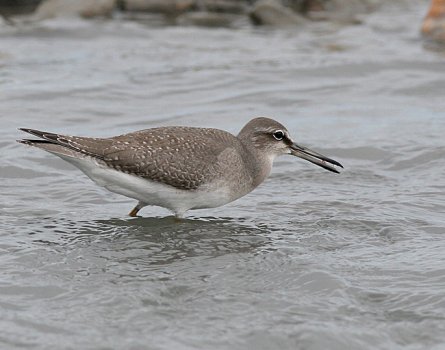 Tringa
brevipes, Taitung, China
Tringa
brevipes, Taitung, China
http://en.wikipedia.org/wiki/File:Tringa_brevipes2.jpg
|
Its breeding habitat is stony riverbeds in northeast Siberia.
It nests on the ground, but these birds will perch
in trees. They also sometimes use old nests of other birds.
Grey-tailed Tattlers are strongly migratory and winter on muddy
and sandy coasts from southeast Asia to
Australia. They are very rare vagrants to western North America
and western Europe. These are not particularly
gregarious birds and are seldom seen in large flocks except
at roosts.
These birds forage on the ground or water, picking up food by
sight. They eat insects, crustaceans and other invertebrates
Source:
http://en.wikipedia.org/wiki/Grey-tailed_Tattler |
As vegetation zones shift to the north, many southern species increase
their ranges.
Chukotka is being rapidly colonized by lynxes, forest
lemmings, dusky thrushes,
magpies, swallows
and numerous southern insects and plants.
So far, northern species don't seem to be in trouble, but things might
change very rapidly.
|
|
|
|
Wandering
tattler, Tringa incana, Ioanna River.
|
The Wandering Tattler, Tringa incana (formerly
Heteroscelus incanus), is a medium-sized wading bird.
It is similar in appearance to the closely related Gray-tailed
Tattler, Tringa. brevipes. (See above)
The tattlers are unique among the species of Tringa for
having unpatterned, greyish wings and backs, and
a scaly breast pattern extending more or less onto the belly
in breeding plumage, in which both also have
a rather prominent supercilium.
These birds have stocky bodies with gray upperparts, underwings,
face and neck and a white belly.
They have short dark yellow legs and a dark gray bill. Adults
in breeding plumage are heavily barred underneath.
In summer, they are found in Alaska and northwestern Canada.
They nest in rocky areas along mountain streams.
At other times, they are found on rocky islands in the southwest
Pacific and on rocky Pacific coasts from
California to South America and as far as Australia.
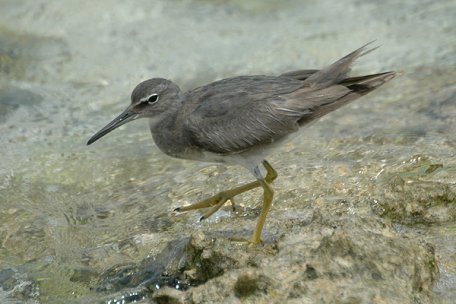 Wandering
Tattler, Tringa incana
Wandering
Tattler, Tringa incana
Attribution:
Aviceda at en.wikipedia |
They feed on aquatic invertebrates such as crustaceans and
marine worms. During breeding season, they also
eat insects. While wading, they forage actively, making jerky
bobbing movements.
The female lays 4 olive-colored eggs in a shallow depression.
Both parents incubate and help feed the young,
who are soon able to forage for themselves.
The call is a rapid trill of accelerating, descending notes
of decreasing volume.
Source:
http://en.wikipedia.org/wiki/Wandering_Tattler
|
|
|

Nest of snowy
owl,
Bubo scandiaca,
Cape Schmidt. |
|
|
|
|
Vega
gulls, Larus vegae, Coal Mines.
|
Warming climate makes it easier for wildlife to cross the Bering Strait.
Asian bird species are now colonizing Alaska, and American ones are
establishing in Siberia
Mammals of lowland tundra are usually difficult to see, but Arctic
ground squirrels are very tame and often live in towns

Arctic ground squirrel tracks,
Belyaka Spit.. |

Arctic ground squirrel, l, Cross Bay. |

Arctic ground squirrel, , Belyaka Spit. |

Arctic ground squirrel, , Anadyr Airport. |
Read about the Arctic
Groundsquirrel here.
Hares of Chukotka have been recently found to belong to an Alaskan
species,
not to mountain hare,
Lepus timidus, of Eurasia.
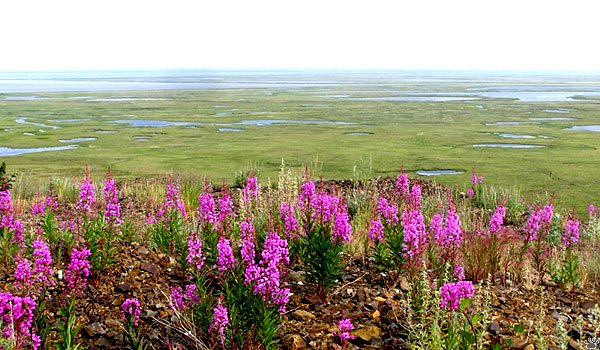
Fireweed,
Epilobium angustifolium, Volchya River Delta, Chukotka |
Part 7. Mountains
Back to
part 5
All
pictures, unless otherwise stated, Copyright © Vladimir
Dinets
|








